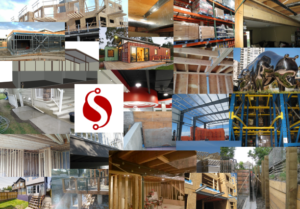 For the past 30 years, Solid has been trying our best to provide 5-star services and products to all our clients. Customer satisfaction is our first priority. We would be happy to help you with your next projects. Please visit our social media sites: Blogger, Google Map, Facebook, as well as Our Blog. Solid was reviewed by TheBestCalgary and given the badge of Best Service.
For the past 30 years, Solid has been trying our best to provide 5-star services and products to all our clients. Customer satisfaction is our first priority. We would be happy to help you with your next projects. Please visit our social media sites: Blogger, Google Map, Facebook, as well as Our Blog. Solid was reviewed by TheBestCalgary and given the badge of Best Service.

Solid Structural Design Ltd. is a one-stop engineering and construction service provider. We help businesses from residential, commercial, institutional, power & energy, oil & gas, agricultural, and water treatment. We are an engineering permit holder from the Association of Professional Engineers and Geoscientists of Alberta (APEGA). Based in Canada, we are open to all opportunities around the world.
The goal of the business is to:
Provide the best engineering and construction solution at the lowest cost;
Utilize the best design practice and technology;
Build the best client relationship;
Form the best management and executive team;
Seek domestic and global partners;
Keep green and sustainable;
Create a win-win situation.
Structural engineering deals with the design and analysis of structures, such as buildings, bridges, dams, towers, and other infrastructure. Structural engineers are responsible for ensuring the safety, stability, and durability of these structures, considering factors like loads, materials, and environmental conditions.
Structural engineers work closely with architects and other professionals to develop the structural design of a project. They consider the intended use of the structure, aesthetic requirements, and functional needs while ensuring it can withstand the anticipated loads and forces.
Engineers perform various calculations and simulations to analyze how a structure will behave under different conditions. They consider factors like gravity loads (e.g., dead loads and live loads), lateral loads (e.g., wind and seismic forces), and temperature effects. Structural analysis helps determine the required sizes and configurations of structural members.
Structural engineers choose appropriate materials for construction based on their strength, durability, and other characteristics. Common materials used in structural engineering include concrete, steel, timber, and composite materials. The selection depends on factors such as the type of structure, expected loads, and budget constraints.
Ensuring the safety of structures is a primary concern for structural engineers. They must adhere to building codes, regulations, and standards established by local authorities. These codes dictate factors such as minimum design loads, material specifications, and construction practices to guarantee structural integrity and occupant safety.
Structural engineers often provide on-site supervision during construction to ensure that the structure is being built according to the design plans and specifications. They collaborate with contractors and construction teams, addressing any issues or challenges that may arise.
Structural engineers may also be involved in retrofitting or rehabilitating existing structures to enhance their safety, adapt them to new uses, or extend their service life. This could involve assessing structural deficiencies, recommending strengthening measures, or conducting structural assessments after events like earthquakes or other disasters.
Advancements in technology, such as computer-aided design (CAD) software, finite element analysis (FEA), and building information modeling (BIM), have significantly improved the efficiency and accuracy of structural engineering processes.